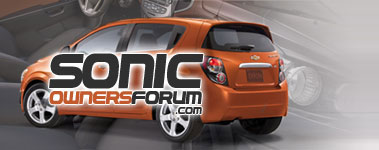Chevrolet’s latest B-segment contender, the Sonic, is pretty darn good. It placed second in a recent six-car comparison test, and nifty interior duds won it a place on our 10Best Design Details list. Things are about to get even more interesting with the turbocharged Sonic RS that will debut at the 2012 Detroit auto show.
RS: Really Sporty
Right off the bat, let’s get one thing out of the way: The Sonic RS won’t pack any additional power. It does, however, look better, and it should handle better and stop shorter, too. Based on the five-door hatchback, the RS wears styling that’s even more pumped-out than that of the standard car. Most of the kit seems transplanted directly from the Aveo RS concept Chevy brought to Detroit two years ago. There’s a more-aggressive fascia up front with an RS-specific grille and unique fog lights, new rocker panels, and a new rear bumper and spoiler. Also included is a nice set of 17-inch wheels.
Chevrolet dressed up the interior in athletic wear, too. There are sport seats, a thicker steering wheel with a flat bottom, aluminum pedals, and a unique instrument-cluster design. Chevrolet’s MyLink infotainment system, which features a seven-inch touch screen and Bluetooth connectivity, will be standard. A smartphone app will be available to push navigation info to the display.
Turn, Stop, Go
While we’re a bit bummed the RS doesn’t get any more power, the turbocharged 1.4-liter four’s 138 hp and 148 lb-ft of torque were good enough to propel a Sonic to 60 mph in just 8.2 seconds in our testing. In this class, that’s pretty quick. Turbo Sonics are currently only available with the stick, but the RS ushers in a new era of choice, offering both the six-speed manual and a six-speed automatic. The auto will be available in other turbocharged Sonics in the spring. Engineers did fiddle with the RS’s gearing a bit—the manual gets closer ratios, and the automatic gets a shorter final-drive—so it will likely be slightly quicker than the standard turbo..
Chevy did a bit more underneath the RS. Its suspension is stiffer and lower, and it will be the only Sonic with rear disc brakes. The electric power steering is untouched, which is fine by us—we found the rack plenty quick in the standard car.
Chevy’s going to have a tough time pricing the RS. Normal Sonics can get pretty expensive, especially the higher trim levels. The last LTZ Turbo we tested cost $19,545—and it wasn’t even fully loaded. Even a modest premium for the RS could push it into the territory of the larger Chevy Cruze and Ford Focus. (If Ford’s Fiesta ST goes into production, it will face a similar problem.) Regardless of the potential price woes, though, we’re excited to see what a racier version of GM’s best-ever small car will be like to drive.




